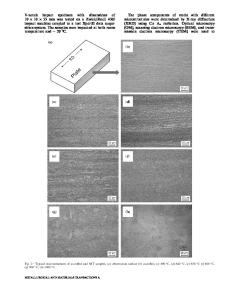Analytical solution for shape evolution of a coherent precipitate in triaxially stressed solid
- PDF / 182,735 Bytes
- 8 Pages / 612 x 792 pts (letter) Page_size
- 98 Downloads / 309 Views
An analytical solution for shape evolution of a coherent misfit precipitate in triaxially stressed solid has been proposed based on Eshelby inclusion theory. With complete energy consideration, the free energy that controls the shape evolution of the precipitate is a function of the precipitate shape, size, triaxially applied stresses, misfit strains, and Young’s moduli of the precipitate and the matrix. Based on the energy analysis, a comprehensive picture of shape evolution of the precipitate is presented.
I. INTRODUCTION
Solid-state phase transformation very often produces second-phase precipitate coherently embedded in parent phase matrix. Morphology of the precipitate, i.e., the size, shape, volume fraction, crystallographic relations with the matrix, plays an important role in determining the properties of the material. The precipitate shape transition during growth and coarsening are known to occur in many alloy systems. For example, in the nickel-based alloy, precipitate shape transitions from spheres to cubes, cubes to plate or rodlike shape, and even splitting into two or more plates are documented.1–3 The final shape of the precipitate depends on the competition between the elastic and interfacial energies. The interfacial energy of a coherent precipitate is roughly proportional to the interfacial area, and its effect on the equilibrium shape have been explored quite thoroughly, and have been placed on a rigorous mathematical footing by Taylor4 and Fonseca.5 Elastic energy may be generated by either far-field applied stresses or by misfit stresses between the precipitate and matrix. When the elastic constants of the precipitate and the matrix are different, the applied stresses have two effects. One effect is that the applied stresses can cause an additional lattice misfit strains between the precipitate and matrix; and the second effect is the coupling potential energy. The influence of elastic energy on the shape evolution, especially for the case where the far-field applied stresses add to the misfit stresses, are relatively less well understood. In the last decade, different theoretical concepts have been developed to investigate the shape evolution of a
a)
Address all correspondence to this author. e-mail: [email protected] DOI: 10.1557/JMR.2004.0392 3068
http://journals.cambridge.org
J. Mater. Res., Vol. 19, No. 10, Oct 2004 Downloaded: 18 Mar 2015
coherent precipitate. Thompson et al.6 used a continuum sharp interface model to investigate equilibrium shapes and shape bifurcations of a precipitate in an elastically anisotropic, homogeneous system with either dilatational or tetragonal misfit strain. A discrete atom method developed by Lee has been used to investigate the evolution of an isolate precipitate in an elastically anisotropic, inhomogeneous system in the presence of either uniform or edge dislocation stress field.7–9 A diffuse interface model developed by Leo et al.10 has been used to study the equilibrium shape of a misfit precipitate in an elastically inhomogeneous system and the in
Data Loading...











